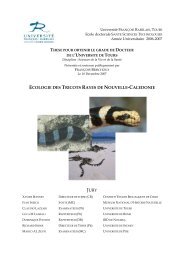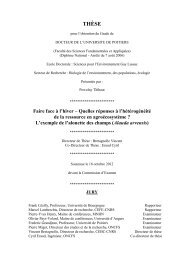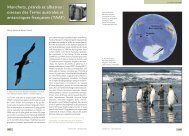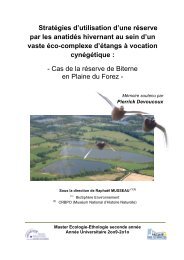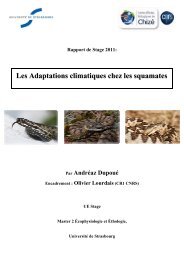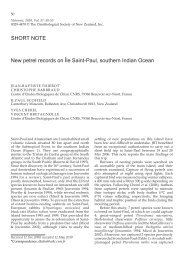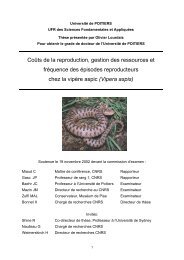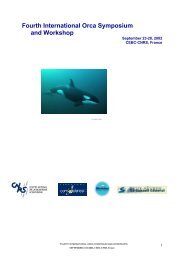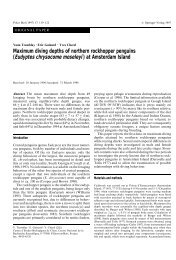Forçage environnemental et prédateurs marins ... - Cebc - CNRS
Forçage environnemental et prédateurs marins ... - Cebc - CNRS
Forçage environnemental et prédateurs marins ... - Cebc - CNRS
You also want an ePaper? Increase the reach of your titles
YUMPU automatically turns print PDFs into web optimized ePapers that Google loves.
Fig. 1. Map indicating the location of Adélie Land in Antarctica and the<br />
study sites near Dumont d’Urville. Most seabird species nest and are studied on<br />
the largest island, where the Dumont d’Urville research station is located<br />
(square).<br />
increasing sea ice season duration have reduced the quantity<br />
and accessibility of the food supplies available in early spring<br />
and may partly explain the delays observed in arrival and laying<br />
dates, with seabirds needing more time to build up the reserves<br />
necessary for breeding (20). However, sea ice extent only<br />
explained up to 24% of the variance in arrival or egg-laying<br />
dates. Given that none of the other climatic factors examined<br />
were related to arrival date or to laying date of first eggs, there<br />
are other factor(s) that are more important than sea ice extent<br />
in d<strong>et</strong>ermining arrival and laying dates.<br />
This unique data s<strong>et</strong> for the southern hemisphere shows<br />
clearly that responses of Antarctic seabirds are opposite to<br />
those observed in the northern hemisphere and the Arctic but<br />
consistent with climatic and oceanographic changes in eastern<br />
Antarctica. The consequences of delayed phenology could be<br />
serious for these top predators if they become less synchronized<br />
with the phenology of their food supplies (21). Interestingly,<br />
the 9.1-day delay in arrival at the colonies and the<br />
Fig. 2. Phenological changes. (A) Dates of first arrival for the emperor<br />
penguin, Aptenodytes forsteri (EMPE) (r 2 0.001; P 0.81); Adélie penguin,<br />
P. adeliae (ADPE) (r 2 0.03; P 0.30); southern giant p<strong>et</strong>rel, M. giganteus<br />
(SGPE) (r 2 0.06; P 0.20); southern fulmar, F. glacialoides (SOFU) (r 2 0.38;<br />
P 0.001); Antarctic p<strong>et</strong>rel, T. antarctica (ANPE) (r 2 0.21; P 0.04); Cape<br />
p<strong>et</strong>rel, D. capense (CAPE) (r 2 0.17; P 0.01); snow p<strong>et</strong>rel, Pagodroma nivea<br />
(SNPE) (r 2 0.001; P 0.83); Wilson’s storm p<strong>et</strong>rel, O. oceanicus (WSPE) (r 2 <br />
0.11; P 0.05); and south polar skua C. maccormicki (SPSK) (r 2 0.07; P 0.09).<br />
(B) Dates of laying of first eggs. Data are shown for EMPE (r 2 0.12; P 0.11),<br />
ADPE (r 2 0.19; P 0.01), CAPE (r 2 0.16; P 0.03), SNPE (r 2 0.004; P 0.73),<br />
and SPSK (r 2 0.11; P 0.05). Regression lines indicate significance of the<br />
trends (solid line, P 0.05; dotted line, P 0.05).<br />
2.1-day delay in the date of laying of the first egg represent, on<br />
average, a 7-day compression of the prelaying period when<br />
birds s<strong>et</strong> up territories and court and females make their<br />
egg(s). The time needed by females to make their egg is<br />
probably under strong physiological constraints, and thus,<br />
presumably, the duration needed for s<strong>et</strong>ting up territories<br />
andor courting decreased, suggesting some plasticity in the<br />
timing of these activities. The fact that Antarctic top predators<br />
already respond to environmental changes by shifts in their<br />
population dynamics (12, 22, 23) and phenology raises some<br />
fascinating questions about how they will be affected by<br />
ongoing climatic trends. Because southern shifts in the distribution<br />
of Antarctic species are extremely limited by the<br />
presence of the Antarctic ice cap, unless microevolutionary<br />
responses to climate change progress with sufficient speed,<br />
these species may be unable to respond appropriately to<br />
changes occurring in their breeding area and therefore may be<br />
Barbraud and Weimerskirch PNAS April 18, 2006 vol. 103 no. 16 6249<br />
ECOLOGY



